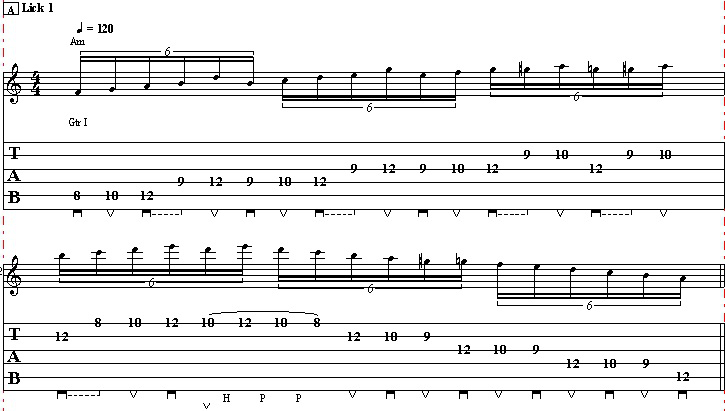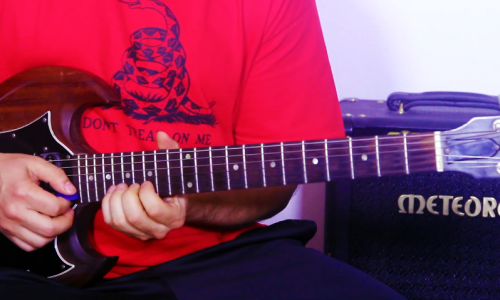How to Play Manic Depression on Guitar
In this Guitar Control video lesson, I’m going to show you how to play “Manic Depression on Guitar”. Another Jimi Hendrix classic! I absolutely love doing Hendrix videos because he’s so great to learn from many different levels. Known world wide as one of the best, if not the best, lead guitarists of all time, he is also insanely creative, he plays with so much emotion and feelings, and so unrestricted.
Jimi Hendrix is a teacher in many ways without even knowing it. He teaches by example, so when learning from him make sure to take note of everything I say, but also to listen to him, and really listen, and see what you discover and can bring back into your own playing and style.

Step 1: The Tuning
To learn how to play “Manic Depression on Guitar”, the first step is to realize he is in a different tuning, other than the standard tuning; 6: E, 5: A, 4: D, 3: G, 2: B, 1; E. Jimi, is tuned down a half step which is called Eb tuning. The symbol that looks like a lowercase letter b, is called a flat sign in music. For this video I am not tuned down, so just for our sake I’m in standard tuning so you can play along with me easily, but if you’re playing along with him, he is tuned down a half step, which means he lowers each string one half step. So instead of the standard tuning being, E, A , D, G, B, E it is now Eb, Ab, Db, Gb, Bb, and Eb, when talking about the 6th string to the 1st.
If your tuner says D# when you play the 6th string, that is also correct because D# and Eb are in harmonic equivalents. Which means they are the same note with a different name. Every flat also has a sharp that it can be called and you decide which one you are using depending if the scale is using sharps or flats, or if any other note in the scale or chord has the same letter name as the sharp or flat you are using.
For instance the D minor scale has one flat, Bb. So the entire scale looks like this; D, E, F, G, A, Bb, C. technically it uses a A and an A# but you would never wanna say, D, E, F, G, A, A#, C. We want to use one of each letter name and keep it clean looking and easy to read and understand. So if your tuner says D# but you were looking for Eb, it’s ok, in this instance it doesn’t matter what it says as long as it is tuned to the correct pitch. So it’s ok if the tuner reads D#, G#, C#, F#, A#, D#. Also the timing of this song is in ¾. The top number referring to how many beats are in the measure and the bottom number referring to the quality of the beat that equals one… meaning quarter note, half note, eighth note etc. So this time signature reads that there are 3 beats per measure and a quarter note equals one. The most common time signature ever and the one you are probably very used to playing is 4/4
which is also ever referred to as “common time” It means that there are 4 beats per measure and a quarter note equals one.
Step 2: The Intro
The Intro starts with two chromatic lines, playing 5th fret, 6th fret, 57th fret, all in a row on the 5th string and then on the 4th string the same thing pick the 5th, 6th, and 7th frets once all in a row. Chromatic means that the notes are right next to one another. The timing of the intro is strictly quarter notes, hitting each quarter note on the first measure, the 5th fret 5th string on beat 1, the 6th fret 5th string on beat 2, and the 7th fret 5th string on beat 3. Then rest for the next measure, so each of those beats, 1, 2, and 3. Then same thing we did on the 5th string on but now on the 4th string. So on beat one of the third measure you play the 5th fret 4th string, on beat 2 you play the 6th fret 4th string and on beat 3 you play the 7th fret 4th string then straight into the next part, so not having a complete measure of silence the on the fourth measure like we did on the second. So 5th string to 4th string and picking, down up down on the 5th string line and doing the same on the 4th string, down up down. If you are enjoying learning this hendrix song make sure you check out my lesson on how to play Purple Haze by Jimi Hendrix, another hendrix classic!
Step 3: Main Riff
I play this riff using my pointer any time I play the 5th fret, my middle finger for the 6th fret, and my ring finger for the 7th fret. This keeps everything very smooth and clean since there is very little movement from your hand because each finger has a specific fret so there is no need to move much.
So to play it, start with an open 5th string, then use your ring finger on the 4th string 7th fret to the 4th string 5th fret and then repeat, the 4th string line one more time, 7th fret to the 4th fret. So the rhythm is 1, 2 &, 3, &. So quarter note for the open 5th string, a quarter note equals one beat, and eighth notes for the rest, an eighth note equals half of one beat. So eighth note on the 4th string 7th fret and the 4th string 5th fret and of course again when we repeat it. The picking directions are down, down up down up.
Step 4: The Hendrix Turnaround Riff
This riff happens directly after the main riff and is just such a hendrix riff I called it the Hendrix turnaround riff. I called it a turnaround riff because it kind of wraps up the previous riff and brings us back to starting over and it just screams hendrix. The feel and note choices give away who is playing this song if you were hearing it for the first time and you had no idea.
Start on the 5th fret 6th string with your pointer. Then we hurry to hammer-on quickly and have this ghost note on the 7th fret 6th string to the 9th fret 6th string. So a hammer on on the 6th string 7th fret to 9th fret with your pointer . Then pick the 5th string 7th fret once. For the very first part when I told you we move quickly remember I don’t slide even though in the video it might almost look like I do, I’m just moving really fast. If you have never heard of a ghost note before a ghost note is a note that isn’t perfectly in time but adds lots of feel and style, they are very common for this genre of music and you will hear them in bluesy players like Jimi Hendrix, Jimmy Page, and Eric Clapton’s playing. They are very cool.
After that line we’re going to do almost the same exact thing starting on the 3rd fret 6th string using your pointer. Then also on the 6th string hammer- on the 5th fret to the 7th, using your pointer finger to your ring finger. But this is where it changes, after the hammer on I drop my pointer finger down to pick the 5th fret 5th string. I actually go back to the note before, picking the 7th fret 6th string with my ring finger.
For the next part we are going to refer back to the intro and take a small part of it to play now! So going to the 5th string only and picking the 5th, 6th, and 7th frets all once and all in a row. Right back into the main riff we are going to hear a ton in this song.
Recap: How to Play Manic Depression on Guitar
I hope you enjoyed learning how to play “Manic Depression on Guitar”. This is such a cool song with so much feel and style. Remember when you learn this songs you are not only learning a song but you are learning how guitar heroes write and what they add to make even their most simple songs stand out. Try and bring these ideas and techniques into your own playing and create your own style and feel.



